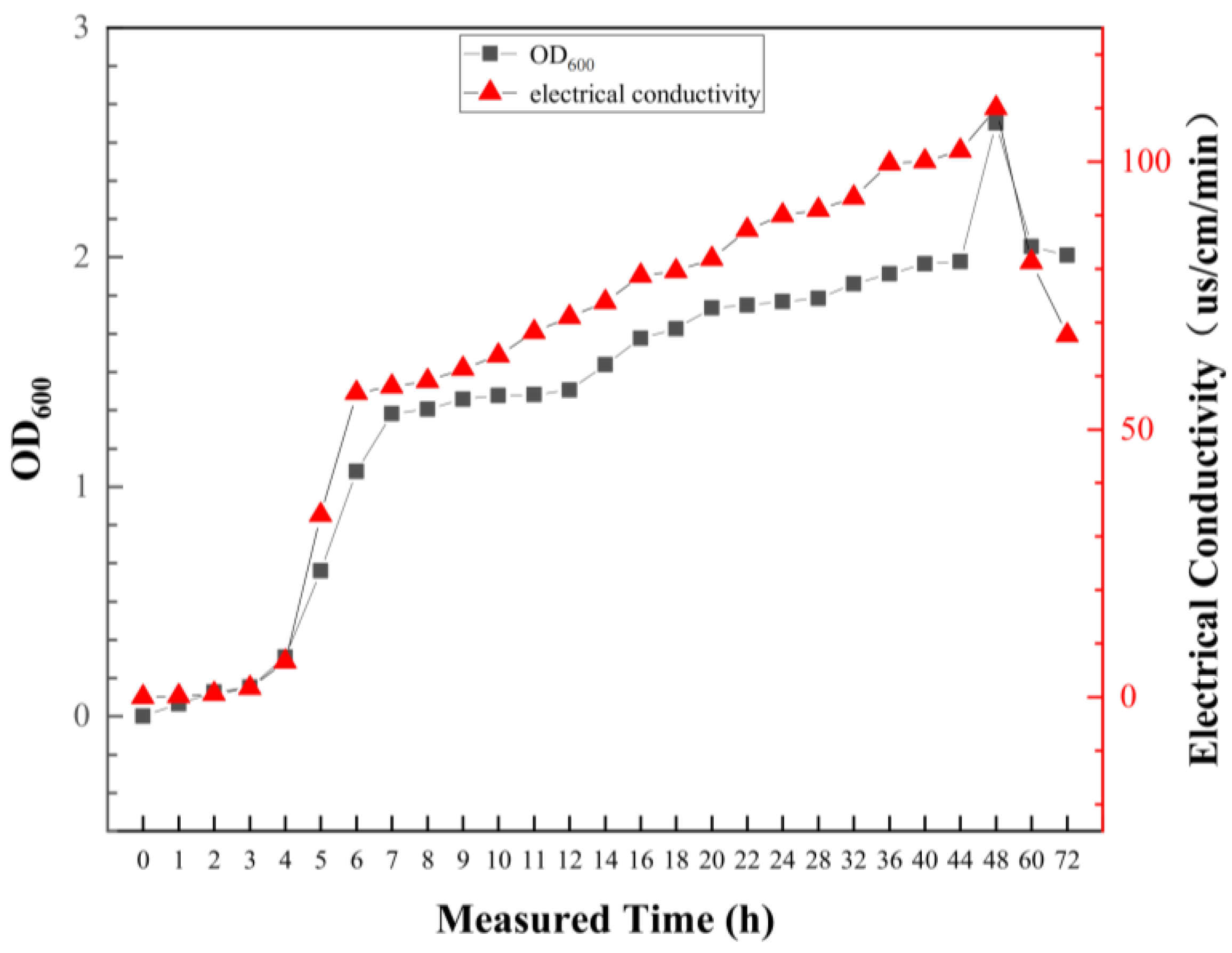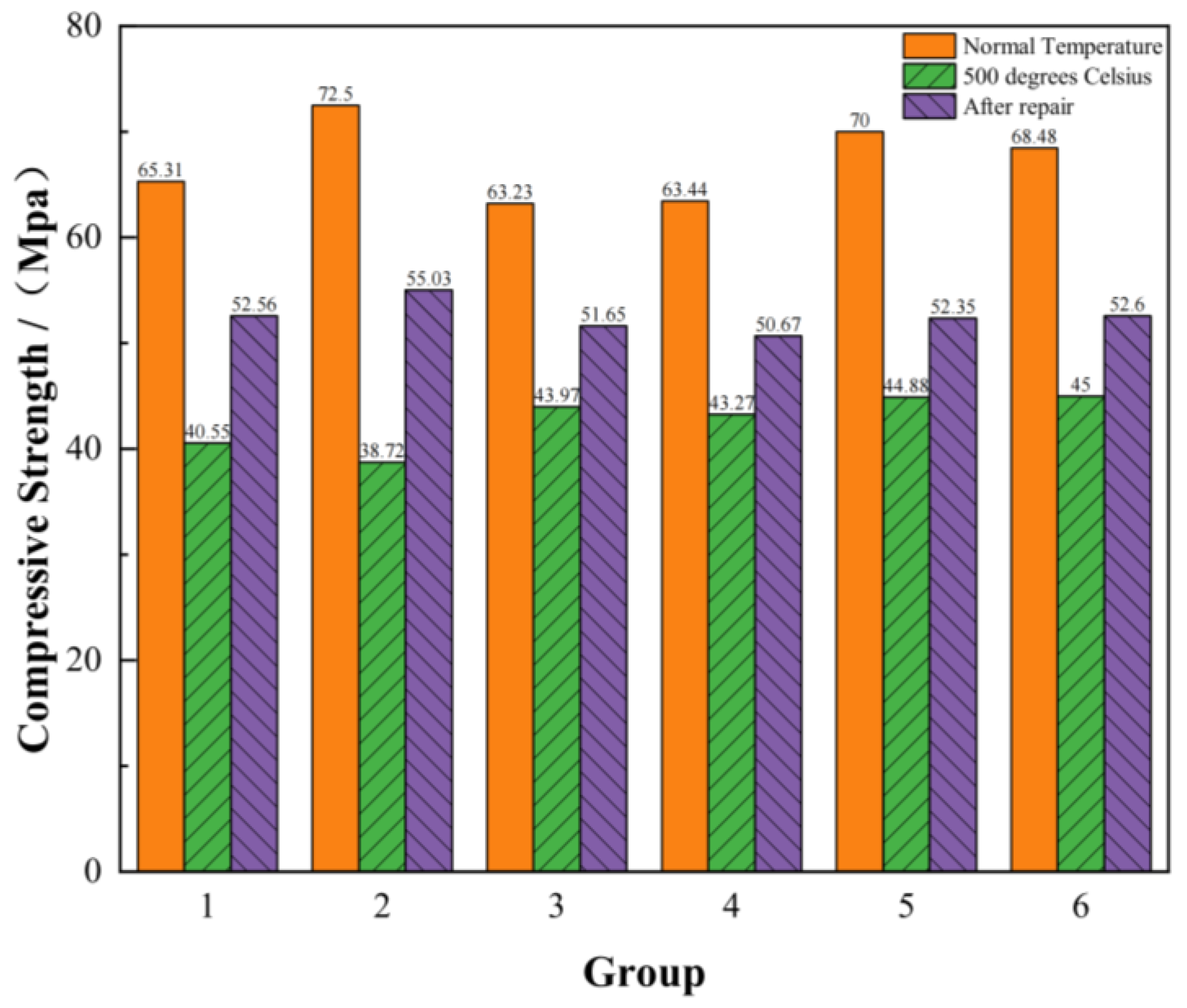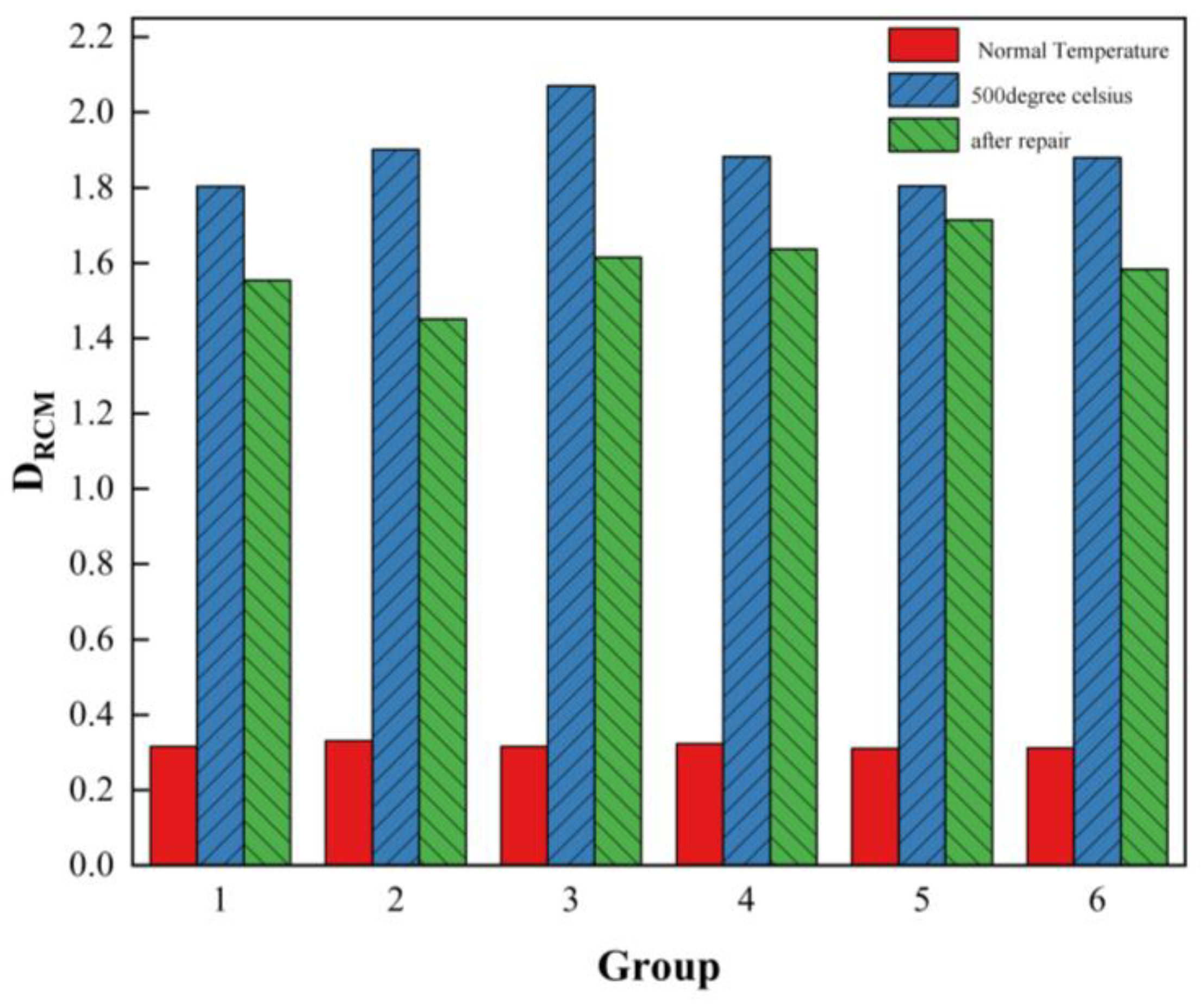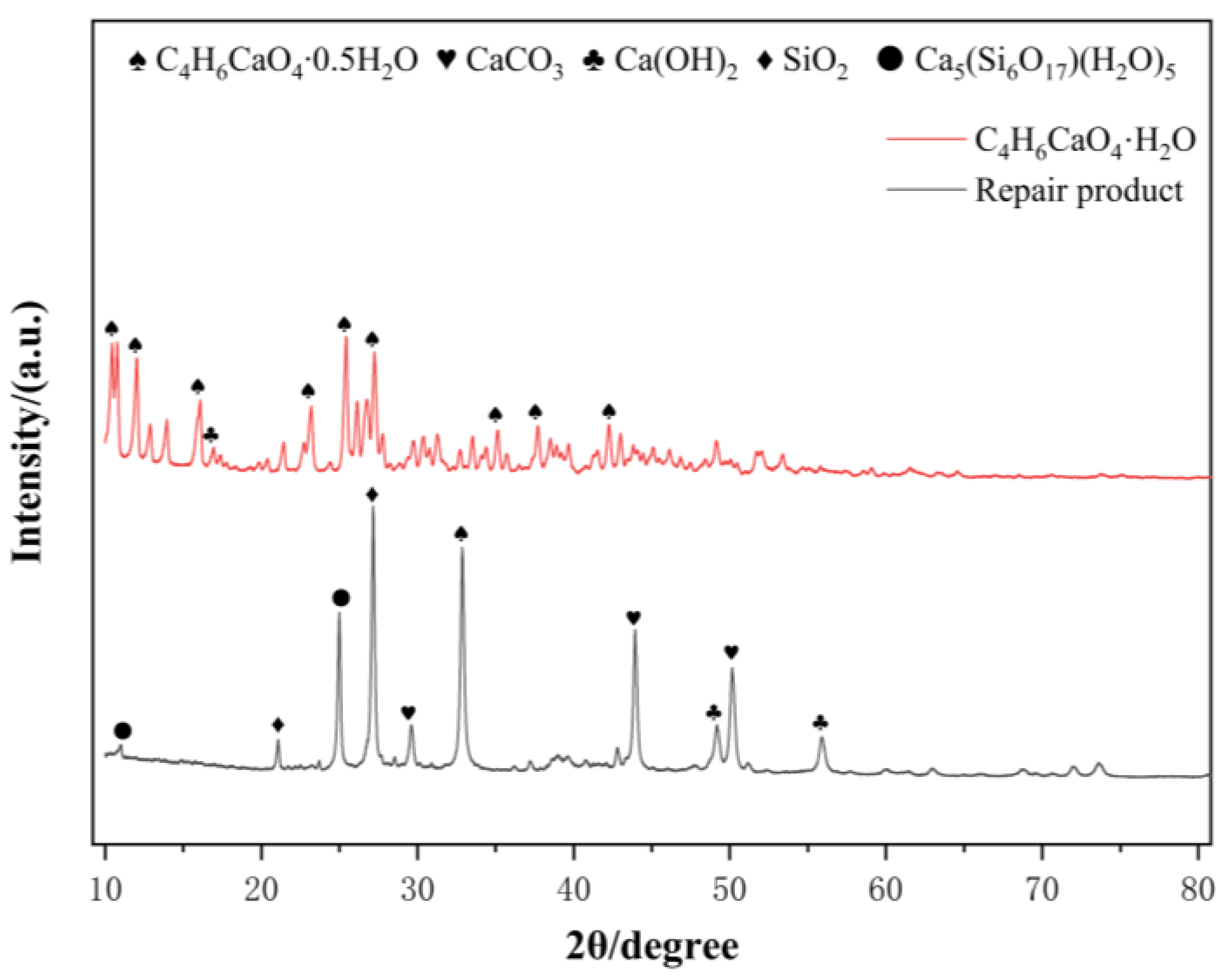Experimental Research into the Repair of High Temperature Damage to Cement Mortar Samples Using Microbial Mineralization Technology
Abstract
:1. Introduction
2. Materials and Methods
2.1. Microbial Sample Preparation and Characterization
2.2. Cement Mortar Test Piece Preparation and High-Temperature Damage Test Method
2.3. Experiment and Characterization of Microbial Mineralization Restoration of High-Temperature Damaged Cement Mortar Specimens
3. Results and Discussion
3.1. Microbial Growth Curve and Selection
3.2. Comparison of Compressive Strength and Chloride Ion Migration Coefficient before and after Restoration
3.3. SEM Photos and XRD Analysis of High-Temperature Damage Products of Cement Mortar Specimens Repaired by Biomineralization
4. Conclusions
- (1)
- After monitoring the growth of microorganisms for 72 h, a linear correlation between OD600 and conductivity was detected. There was a linear increase within 48 h after the inoculation of the solid medium into the liquid medium, after which there was a decline. At 48 h, the OD600 was 2.585, and the conductivity was 110 μs/cm/min. The bacterial solution obtained at 48 h was used in the mineralization test.
- (2)
- The application of microbial mineralization for repairing 500 °C damaged cement mortar specimens resulted in an improvement in both the compressive strength and chloride ion penetration resistance. The repairing rate of the specimen damaged at 500 °C was found to be 78.2%. This percentage was calculated by comparing the compressive strength of the repaired specimen to that of the undamaged specimen.
- (3)
- The analysis of the repair products indicated that CaCO3 was mainly responsible for the restoration of high-temperature, damaged cement mortar specimens. The CaCO3 exhibited moderate strength, and a portion of the pores was filled with calcium silicate hydrate. The high-temperature alkaline environment somehow affected the cracks, resulting in a reduced mineralization effect by microorganisms. Several factors influenced the crystal morphology of the repaired CaCO3 product, for example, temperature, pH, order of introduction of calcium sources, etc.
- (4)
- Through the study of microbial repair of high temperature damage to cementitious sand specimens, further microbial repair methods and effects after high temperature damage to concrete specimens can be explored, and after a reasonable construction method, this will potentially make the MICP technique one of the repair methods after fire damage to concrete buildings.
Author Contributions
Funding
Institutional Review Board Statement
Informed Consent Statement
Data Availability Statement
Conflicts of Interest
References
- Wang, C. Analysis of Causes of Fire in High-Rise Buildings and Countermeasures for Fire Safety. Hous. Real Estate 2019, 155. [Google Scholar]
- Du, H. A New Method for Fire Damage Detection and Assessment of Reinforced Concrete Structures; Chemical Industry Press: Beijing, China, 2018. [Google Scholar]
- Li, Q. Research on High Temperature Damage Evolution of C80 High Performance Concrete Microstructure; Taiyuan University of Technology: Taiyuan, China, 2017. [Google Scholar]
- Qian, C.; Ren, L.; Luo, M. Research progress on repairing technology of concrete surface defects and cracks based on microbial induced mineralization. J. Silic. 2015, 43, 619–631. [Google Scholar]
- Xu, J. Research progress of concrete crack repair based on microbial mineralization deposition. J. Zhejiang Univ. Eng. Sci. Ed. 2012, 46, 2020–2027. [Google Scholar]
- Yuan, X.; Sun, W.; Chen, H. Research and progress of microbial repair technology for cracks in cement-based materials. J. Ceram. 2009, 37, 160–170. [Google Scholar]
- Qian, C.; Li, R.; Pan, Q.; Li, R. Formation mechanism of microbial mineralized calcite in self-healing concrete. J. Ceram. 2013, 41, 620–626. [Google Scholar]
- Qian, C.; Li, R.; Pan, Q.; Luo, M.; Rong, H. Effect of microbial self-healing of concrete cracks. J. S. Univ. Nat. Sci. Ed. 2013, 42, 360–364. [Google Scholar]
- Wang, J.; Jonkers, H.M.; Boon, N.; De Belie, N. Bacillus sphaericus LMG 22257 is physiologically suitable for self-healing concrete. Appl. Microbiol. Biotechnol. 2017, 101, 5101–5114. [Google Scholar] [CrossRef] [PubMed]
- Wang, J.; Vandevyvere, B.; Vanhessche, S.; Schoon, J.; Boon, N.; De Belie, N. Microbial carbonate precip-itation for the improvement of quality of recycled aggregates. J. Clean. Prod. 2017, 156, 355–366. [Google Scholar] [CrossRef]
- Wang, R.; Qian, C.; Wang, J.; Cheng, L. Different processes of microbial deposition of calcium carbonate coating on the surface of cement stone. J. China Ceram. Soc. 2008, 36, 1378–1384. [Google Scholar]
- Whiffin, V.S. Microbial CaCO3, Precipitation for the Production of Biocement; Murdoch University: Perth, Australia, 2004. [Google Scholar]
- Salama, N.R.; Hartung, M.L.; Muller, A. Life in the human stomach:persistence strategies of the bacterial pathogen Helicobacter pylori. Nat. Rev. Microbiol. 2013, 11, 385–399. [Google Scholar] [CrossRef] [PubMed]
- Mobley, H.L.T. Characterzation of urease from Campylobacter pylori. J. Clin. Microbiol. 1988, 26, 831–836. [Google Scholar] [CrossRef] [PubMed]
- Talaiekhozani, A.; Keyvanfar, A.; Andalib, R.; Samadi, M.; Shafaghat, A.; Kamyab, H.; Hussin, M.W. Application of Proteus mirabilis and Proteus vulgaris mixture to design self-healing concrete. Desalination Water Treat. 2014, 52, 3623–3630. [Google Scholar] [CrossRef]
- OnalOkyay, T.; Frigi Rodrigues, D. High throughput colorimetric assay for rapid urease activity quantification. J. Microbiol. Methods 2013, 95, 324–326. [Google Scholar] [CrossRef] [PubMed]
- Braissant, O.; Verrecchia, E.P.; Aragno, M. Is the contribution of bacteria to terrestrial carbon budget greatly underestimated? Naturwissenschaften 2002, 89, 366–370. [Google Scholar] [CrossRef] [PubMed]
- Wang, R.; Qian, C. Repairing surface defects of cement-based materials by microbial deposition of calcium carbonate. Chin. J. Ceram. 2008, 36, 457–464. [Google Scholar]





| Species | Tryptone (g) | Bean Peptone (g) | NaCl (g) | Agar (g) | Urea (g) | Deionized Water (mL) |
|---|---|---|---|---|---|---|
| Solid medium | 15.0 | 5.0 | 5.0 | 15.0 | 20.0 | 1000.0 |
| Fluid medium | 15.0 | 5.0 | 5.0 | 0 | 20.0 | 1000.0 |
| Cement (g) | Sand (g) | Fly Ash (g) | Water (g) | Mineral Powder (g) | Metakaolin (g) | Silica Ash (g) |
|---|---|---|---|---|---|---|
| 315 | 1350 | 90 | 202.5 | 0 | 45 | 0 |
Disclaimer/Publisher’s Note: The statements, opinions and data contained in all publications are solely those of the individual author(s) and contributor(s) and not of MDPI and/or the editor(s). MDPI and/or the editor(s) disclaim responsibility for any injury to people or property resulting from any ideas, methods, instructions or products referred to in the content. |
© 2023 by the authors. Licensee MDPI, Basel, Switzerland. This article is an open access article distributed under the terms and conditions of the Creative Commons Attribution (CC BY) license (https://creativecommons.org/licenses/by/4.0/).
Share and Cite
Zhao, T.; Du, H.; Wang, L. Experimental Research into the Repair of High Temperature Damage to Cement Mortar Samples Using Microbial Mineralization Technology. Appl. Sci. 2023, 13, 9403. https://doi.org/10.3390/app13169403
Zhao T, Du H, Wang L. Experimental Research into the Repair of High Temperature Damage to Cement Mortar Samples Using Microbial Mineralization Technology. Applied Sciences. 2023; 13(16):9403. https://doi.org/10.3390/app13169403
Chicago/Turabian StyleZhao, Teng, Hongxiu Du, and Linhao Wang. 2023. "Experimental Research into the Repair of High Temperature Damage to Cement Mortar Samples Using Microbial Mineralization Technology" Applied Sciences 13, no. 16: 9403. https://doi.org/10.3390/app13169403
APA StyleZhao, T., Du, H., & Wang, L. (2023). Experimental Research into the Repair of High Temperature Damage to Cement Mortar Samples Using Microbial Mineralization Technology. Applied Sciences, 13(16), 9403. https://doi.org/10.3390/app13169403





